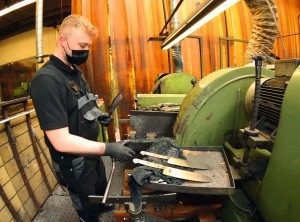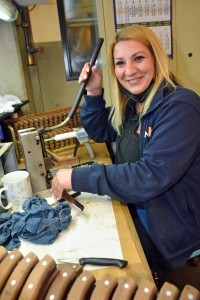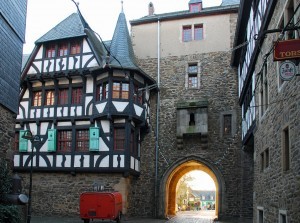"Made in Solingen" is a world-renowned - and protected - seal of quality for blades that last a lifetime. To this day, the international export hits are still largely made by hand in the family tradition.
The matt blank is still one of dozens in the delivery area of the Felix knife manufactory. However, as soon as it has lost its oxide layer in the first machine sharpening and has undergone a metamorphosis that can take more than forty work steps, only the rough shape of the blade is reminiscent of its original state. At the end of the production chain is a gleamingly polished, elegant knife that can be easily balanced in front of the handle with just one finger, so that even hours of kitchen work under time pressure can be carried out with ease. A close look at the X-50 steel blade reveals not only the finest grooves, but also deliberately calculated irregularities to reduce the adhesion of stubborn cutting substances. The masterpiece has passed through a dozen or so hands before the final inspection ... namely those of professional "freehand artists" such as plasterers, honers and reeders. "Unfortunately, we can't forge them ourselves," says Managing Director Rosario Catalano, looking at the blanks with a hint of regret in his voice. Today, he notes, there are barely a handful of forges left in the North Rhine-Westphalian business location, which has borne the officially protected nickname "City of Blades" since 2012.
Damascus, Toledo, Japan... Solingen?
 First processing step: The blanks blackened by forging are polished to a bright finishIn fact,the sometimes endearingly sleepy-looking city in the Bergisches Land region is considered the capital of the cutlery industry, with around 90 percent of all German knife and cutlery manufacturers. Solingen plays in the top league worldwide, especially in the production of high-quality blades. Its excellent reputation is based on valuable raw materials such as high-alloy steels, as well as centuries of accumulated knowledge and experience when it comes to forging and grinding techniques and the best steel mix with optimized carbon content for the respective area of application. Amateur and star chefs all over the world swear by the edge retention, durability, hardness and feel of the blades from Solingen.
First processing step: The blanks blackened by forging are polished to a bright finishIn fact,the sometimes endearingly sleepy-looking city in the Bergisches Land region is considered the capital of the cutlery industry, with around 90 percent of all German knife and cutlery manufacturers. Solingen plays in the top league worldwide, especially in the production of high-quality blades. Its excellent reputation is based on valuable raw materials such as high-alloy steels, as well as centuries of accumulated knowledge and experience when it comes to forging and grinding techniques and the best steel mix with optimized carbon content for the respective area of application. Amateur and star chefs all over the world swear by the edge retention, durability, hardness and feel of the blades from Solingen.
If you want to understand why this region, dotted with half-timbered houses and wooded hills, has become a world leader in the industry, you need to immerse yourself in the history of this idyllic region in the low mountain range between Düsseldorf in the west and the Ruhr area in the north. However, the success story of Solingen steel has only a limited connection to its geographical proximity to the once mouse-grey world of collieries and blast furnaces between Essen and Dortmund. The craft, which is surrounded by local legends about figures such as the blacksmith Wieland and Master Ruthard, has its roots in the late Middle Ages, around 1300, when numerous farms were founded in the stream valleys in what is now the city area, often with hammer mills and water mills attached to them. These included the typical grinding cottages - huts whose grindstones were operated using the water power of streams and rivers such as the Wupper to sharpen field tools such as scythes and sickles. Evidence of this period can still be found in and around Solingen today, such as grinder museums ("Wipperkotten" and "Balkhauser Kotten"), millstones embedded in the pavement and the locally produced armor and edged weapons on display at Schloss Burg. A number of locational advantages, such as the availability of ore from the Cologne area, the water power of numerous streams, old Roman roads and, last but not least, Father Rhine, created an ideal breeding ground for technical innovations and increasingly sophisticated forging and grinding technology. And: the secret of blade hardening was discovered - perhaps the decisive criterion for the quality of Solingen blades in addition to their durability. In the late 18th century, steam engines and electricity paved the way for the structural change from rural to industrial production.
From a court smithy to a manufactory
 Precious woods are sometimes used to rivet on the handle scales. Plastic handles, on the other hand, are glued Live during this period of upheaval was Karl Gustav Felix from Solingen, who recognized the signs of the times with his family. His skill and knowledge in the art of cutlery took him straight from the court smithy to the office to register his trade. Founded in 1790, Gustav Felix Schneidwarenfabrik is now one of the oldest knife manufacturers in the world. Even if it doesn't sound very romantic, the fact that the Swiss Zepter Group took over the traditional company in 2012 after more than 220 years of family ownership not only secured the location, jobs and production, but also the expertise passed down over the centuries and the craftsmanship itself, which is now being carried into the future by young apprentices. The fact that Ruth Felix herself accompanied the transition phase for two years underlines just how close to her heart this is.
Precious woods are sometimes used to rivet on the handle scales. Plastic handles, on the other hand, are glued Live during this period of upheaval was Karl Gustav Felix from Solingen, who recognized the signs of the times with his family. His skill and knowledge in the art of cutlery took him straight from the court smithy to the office to register his trade. Founded in 1790, Gustav Felix Schneidwarenfabrik is now one of the oldest knife manufacturers in the world. Even if it doesn't sound very romantic, the fact that the Swiss Zepter Group took over the traditional company in 2012 after more than 220 years of family ownership not only secured the location, jobs and production, but also the expertise passed down over the centuries and the craftsmanship itself, which is now being carried into the future by young apprentices. The fact that Ruth Felix herself accompanied the transition phase for two years underlines just how close to her heart this is.
Much of the production has remained traditional manual work to this day, as becomes clear during the factory tour. It goes without saying that the little secrets that have been kept for centuries are not revealed and the one or other reportage picture is checked for special details. Nevertheless, Managing Director Catalano, a second-generation Solingen native who is already active in the industry, provides quite deep insights into production during the factory tour.
And this begins with the aforementioned metal boxes full of different blanks. The chaff from overseas is separated from the local wheat right from the original form: in contrast to mass-produced products, the blanks are drop-forged or punched by hand and heated in one piece to ensure the best possible structural stability. For each type of knife, the question arises as to the most suitable type of steel depending on the respective application. Felix uses high-alloy X50 CrMoV15 chrome-molybdenum-vanadium blade steel, VG10 Japanese shaped Damascus multi-layer steel or X65 CR13 razor blade steel. Even if the dense and uniform fiber structure of the microstructure in the steel guarantees flexibility, corrosion resistance and high edge retention - i.e. high resharpening quality - the formula requires a compromise. To put it bluntly: it is not possible to be both durable and easy to clean at the same time. The very common X50 blade steel (carbon content 0.5 %) offers the best compromise between edge retention and low susceptibility to rust, while X65 razor blade steel (carbon content 65 %) has a correspondingly higher edge retention, but is very maintenance-intensive, which is why Felix is one of the last suppliers of such blades. Rosario Catalano explains: "If you leave a knife like this damp in the sink after cutting lemons, it will rust in no time at all." Real professionals, on the other hand, appreciate the fact that these blades can be sharpened to their original sharpness even after many years, as Catalano notes. "In direct comparison, a mass-produced product from China is only sharp at first and never regains its original sharpness when resharpened." The beautiful Damascus blades are also optical flagships in his company with around 40 employees: depending on the model, the steel - including high-alloy Swedish steel, which is considered to be the world's best so-called wild Damascus - is folded several times and thus completely fused. The distinctive grain, reminiscent of tree rings, is only created in an acid bath at a certain temperature and consistency. Because the acid only attacks certain areas of the stainless steel blade, the pattern in the unique piece is somewhat reminiscent of cut puff pastry.
 A metal body that extends to the end of the handle scales is a quality feature and ensures perfectly balanced knives
A metal body that extends to the end of the handle scales is a quality feature and ensures perfectly balanced knives
Scales prevent sticking to the blade
 Solingen is worth a visit even without a tour of the company: here the gate area of Burg Castle on the WupperBackto production. After the incoming goods inspection, the first mechanical sharpening is carried out on old but reliable machines, which, like the decades-old whetstones, come from the immediate region. During these rather rough initial production steps, the blanks are first and foremost ground on the back of the stone and water, with the latter being cleaned of metal shavings using magnets and recycled in a closed cycle for over a year. If required for the model in question, a precision machine presses the bolsters - indentations running parallel to the blade that prevent sticky or thin cutting material from adhering - before a person takes over the fine work that no machine can replace and which is one of the special quality features of Solingen blades. Even handle assembly requires dexterity and experience, especially as sawing, fitting, drilling, rivet assembly and gluing or fusing - depending on whether the handles are made of wood or plastic - is more time-consuming than one might expect. And it is also more important than it seems. After all, the knife should sit as comfortably as possible in the hand and be balanced to prevent wrist fatigue when working in the kitchen. You should simply be able to feel the quality.
Solingen is worth a visit even without a tour of the company: here the gate area of Burg Castle on the WupperBackto production. After the incoming goods inspection, the first mechanical sharpening is carried out on old but reliable machines, which, like the decades-old whetstones, come from the immediate region. During these rather rough initial production steps, the blanks are first and foremost ground on the back of the stone and water, with the latter being cleaned of metal shavings using magnets and recycled in a closed cycle for over a year. If required for the model in question, a precision machine presses the bolsters - indentations running parallel to the blade that prevent sticky or thin cutting material from adhering - before a person takes over the fine work that no machine can replace and which is one of the special quality features of Solingen blades. Even handle assembly requires dexterity and experience, especially as sawing, fitting, drilling, rivet assembly and gluing or fusing - depending on whether the handles are made of wood or plastic - is more time-consuming than one might expect. And it is also more important than it seems. After all, the knife should sit as comfortably as possible in the hand and be balanced to prevent wrist fatigue when working in the kitchen. You should simply be able to feel the quality.
Alfons Schuhbeck cooks with Felix knives
 The most important work is probably sharpening the blades. The right angle is important here, 15 degrees is idealThenext steps are based on centuries-old local expertise: In up to 15 steps, the blades are first coarsely ground on coated whetstones and then ground finer and finer using increasingly smaller grain sizes. In Solingen jargon, this fine grinding process is known as "Pließten" or "Blaupließten" because the blades shimmer blue after treatment with special grease and the so-called "Pließtscheiben". This also closes the pores in the steel that were opened during rough grinding in order to create rust-resistant products. Decades-old whetstones from old family stocks are used for the subsequent "smoothing" process, which are covered with roughened leather, rubber and felt. The result is flawlessly polished and highly polished blades that offer hardly any surface for acids to attack. Also in the finishing shop, the handles are then sanded by hand to a velvety soft finish and repeatedly checked with the fingertips before the knives are "christened". The company name and logo are etched in, but laser technology is also used for special customer requests. The same applies to the final sharpening, the trigger. To ensure that the blade is sharpened at the optimum angle of 15 degrees on each side, the laser beam hits the cutting edge precisely and is split symmetrically on both sides. The final quality control is carried out after the cutting test under special light - once again a task for experienced eagle eyes - before the knives are neatly lined up after cleaning, dried and left to rest.
The most important work is probably sharpening the blades. The right angle is important here, 15 degrees is idealThenext steps are based on centuries-old local expertise: In up to 15 steps, the blades are first coarsely ground on coated whetstones and then ground finer and finer using increasingly smaller grain sizes. In Solingen jargon, this fine grinding process is known as "Pließten" or "Blaupließten" because the blades shimmer blue after treatment with special grease and the so-called "Pließtscheiben". This also closes the pores in the steel that were opened during rough grinding in order to create rust-resistant products. Decades-old whetstones from old family stocks are used for the subsequent "smoothing" process, which are covered with roughened leather, rubber and felt. The result is flawlessly polished and highly polished blades that offer hardly any surface for acids to attack. Also in the finishing shop, the handles are then sanded by hand to a velvety soft finish and repeatedly checked with the fingertips before the knives are "christened". The company name and logo are etched in, but laser technology is also used for special customer requests. The same applies to the final sharpening, the trigger. To ensure that the blade is sharpened at the optimum angle of 15 degrees on each side, the laser beam hits the cutting edge precisely and is split symmetrically on both sides. The final quality control is carried out after the cutting test under special light - once again a task for experienced eagle eyes - before the knives are neatly lined up after cleaning, dried and left to rest.
In this way, around 600 knives are produced each week, which have no chance of gathering dust in the warehouse. Whether TV chefs like Alfons Schubeck in Munich or customers in Fiji or New Zealand, who not only accept the freight costs but also reorder - unique items from the Felix manufactory find their buyers, as do most top products. Incidentally, imitators and cheap producers from the Far East are not only at a disadvantage in terms of quality, as the "Made in Solingen" attribute is also legally protected in addition to the "Klingenstadt" designation. In contrast to the "Made in Germany" label, which can be legally used even when using inferior raw materials from abroad, as long as the assembly takes place in Germany, 95 percent of the production steps must take place in Solingen for a blade to be adorned with the coveted seal of quality. But they try anyway ... The Solingen "Plagiarius" museum is a great place to smile about how brand theft definitely doesn't work.


